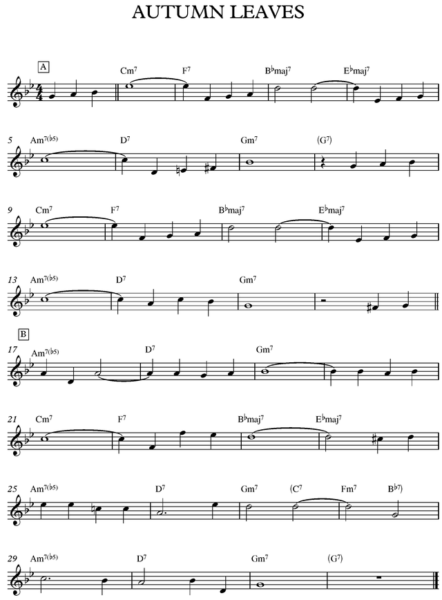Lesson 11: playing jazz standards
A guide to playing jazz standards, part 2.
Lesson 11 of Learn Jazz Piano Online continues with the theme of playing jazz standards. This jazz lesson is called Autumn Leaves part 2 and picks up where lesson 10 left off. This lesson is divided up into three sections: head, comp and solo.

Head – this is just the jazz term for the tune or melody. Because we have been using shells in our left hand, this sometimes creates a rather bare sound when we play just the melody note in the right hand. Shells play 1 and 7 or 1 and 3 of the chord. Most chord voicings require the 1, 3 and 7 in order that the harmony makes sense. Once these three notes are present, we can then add ‘filler’ notes like 5, 9 etc.
In Autumn Leaves, the melody mostly hits the 3. If the shell is playing 1 + 7, then a good filler note might be 5. Remember that it’s the dominant seventh chord that provides all the potential tension. Therefore, our voicing can include altered notes (secondary extensions) to add some spice. These 4 notes are b9, #9, #11 and b13.
Comp – we are at present using a 4-note comp. Once again, look out for the dominant seventh chords, for it’s here that we can include the altered notes. In Autumn Leaves we already have F7 and D7 but in this lesson we add G7. This is known as a secondary dominant.
Solo – In lesson 10 we used horizontal improvisation. This is when we can use one parent scale to play over a family of related chords. In lesson 10 we are starting to solo more vertically, and, once again, when soloing over jazz standards, the dominant sevenths give us the opportunity to deviate from the parent scale. For example, the chord F7 allows us to play Gb, G# and Db, respectively b9, #9 and b13.
We also revisit ‘walking 3s’. We target the 3 of each chord and walk between these chords on their ‘parent’ track. Once we are walking 3s we are then able to use the diminished chords contained within the dominant seventh (3+5+7) and then play another minor 3rd interval above the 7. This results in the b9.
If you have any questions about playing jazz standards, please ask.
You can click here to enrol on my course.
Iím not that much of a internet reader to be honest but your blogs really nice, keep it up! I’ll go ahead and bookmark your site to come back in the future. All the best